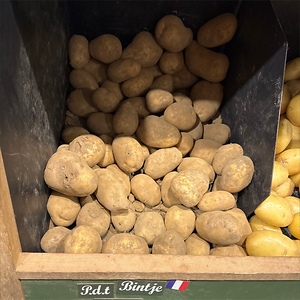


Bintje Potatoes
Estimated Inventory, lb : 0
Description/Taste
Bintje potatoes vary in size depending on soil and growing conditions. They are generally small to medium-sized tubers averaging 7 to 10 centimeters in length and have a somewhat uniform, oval to oblong shape with blunt, curved ends. The thick spuds have thin, smooth, and taut skin, and the eyes are shallow, making the tubers easy to prepare and peel. The skin is typically pale yellow and has a textured, semi-rough feel, sometimes sold with a thin layer of dirt encasing the surface. Underneath the skin, the golden yellow flesh is firm, dense, and slippery when raw, becoming soft, tender, and buttery once cooked. Bintje potatoes are known for having balanced levels of moisture and starch, creating a versatile texture for waxy and floury potato preparations. Bintje potatoes are edible cooked and have a mild, subtly sweet, and nutty taste.
Seasons/Availability
Bintje potatoes are available year-round, with a peak season in the summer through fall.
Current Facts
Bintje potatoes, botanically classified as Solanum tuberosum, are a Dutch variety belonging to the Solanaceae or nightshade family. The heirloom cultivar is a middle-early variety developed in the 20th century and was selected as a commercial tuber for its uniform appearance, mild flavor, and versatility. After their release to European markets, Bintje potatoes were one of the most popular cultivars for processing as the variety was high-yielding and had extended storage capabilities. Bintje potatoes are harvested 90 to 130 days after sowing and are also known as Miss Bintje potatoes in markets. In the modern day, the variety has faded from widespread production, but it is still grown in home gardens and through select farms in Europe, especially in France and Belgium. Bintje potatoes are favored for their all-purpose nature and are utilized by chefs and home cooks in a wide array of savory culinary preparations.
Nutritional Value
Bintje potatoes are a source of vitamin C to strengthen the immune system and B vitamins to assist the body in energy production. Potatoes also provide fiber to regulate the digestive tract, zinc to repair damaged tissues, and minerals such as iron, phosphorus, calcium, and potassium. Iron develops the protein hemoglobin for oxygen transport through the bloodstream, calcium and phosphorus support bones and teeth, and potassium balances fluid levels within the body.
Applications
Bintje potatoes have a mild, sweet, and nutty taste suited for cooked preparations. The all-purpose variety can be used in recipes calling for waxy or floury potatoes and can hold their shape well. Bintje potatoes are famously used to make fries and develop a crisp exterior and a soft, fluffy interior. In Belgium, the Netherlands, and France, Bintje potatoes are one of the top fry varieties and are customarily served with condiments like onions, ketchup, or mayonnaise. In France, fries are known as pommes frites and are a common side dish served in cafes and bistros. Bintje potatoes are also made into mashed potatoes and are a variety of choice for stamppot, a Dutch comfort food. Stamppot is comprised of mashed potatoes mixed with vegetables like carrots, endive, or kale. Try roasting Bintje potatoes in quarters as a simple side or simmering in stews, soups, and curries. Bintje potatoes are also incorporated into gratins and casseroles, notably gratin dauphinois in France. They are also braised with meats, especially roast beef or veal. Bintje potatoes pair well with herbs such as chives, rosemary, parsley, and thyme, cheeses including parmesan, gruyere, and cheddar, and vegetables like bell peppers, broccoli, and carrots. Whole, unwashed Bintje potatoes will keep for several weeks when stored in a cool, dry, and dark location. Once cooked, keep leftovers in the fridge in a container for 3 to 4 days.
Ethnic/Cultural Info
Bintje potatoes were named after one of Kornelis Lieuwes de Vries’s former students, Bintje Jansma. During his career, Kornelis Lieuwes de Vries was a member of the Frisian Society of Agriculture and worked with the Society to breed new potato cultivars. He obtained a horticulture degree in addition to his teaching degree in 1901 and established a potato field where he experimented with breeding. De Vries also filled his school’s windowsills with potato seedlings and used his field as a hands-on teaching tool with his students, involving them in the breeding process. De Vries created over 125 potato varieties, and Bintje potatoes were the tenth he had made in his career. It was customary for De Vries to name his potato cultivars after his children and students, and Bintje was chosen after his former student, Bintje Jansma. At the time of the tuber’s release, Jansma was seventeen years old. Bintje potatoes were De Vries’ most successful cultivar, and it is said that a stone carving of two potato plants was constructed in Suameer to commemorate the teacher’s breeding achievements.
Geography/History
Bintje potatoes are native to the Netherlands and were developed in the early 20th century in the village of Suameer, also known as Sumar. Frisian schoolmaster Kornelis Lieuwes de Vries created the variety from a cross between Fransen and Munstersen potatoes. In 1905, tubers were selected from the Munstersen and Fransen cross and were later named Bintje as a new commercial variety. The cultivar was officially released in 1910, and after its debut, it became an essential potato for French fry production. By 1987, Bintje potatoes accounted for over sixty percent of the potatoes grown in the Netherlands, and the variety was introduced to growers throughout Europe. Despite their popularity, Bintje potatoes were sometimes challenging to cultivate due to diseases, leading to their eventual disappearance among Dutch growers. The variety continued to thrive in other regions of Europe and remained a favored cultivar in France and Belgium. Today, Bintje potatoes are cultivated in commercial farms and home gardens in Europe, North Africa, Canada, and Australia. When in season, Bintje potatoes are sold through local markets, retailers, and wholesalers.








